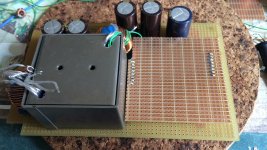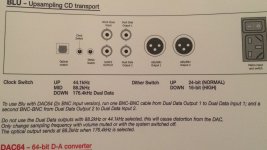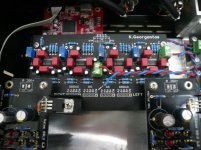My dacs are generally ungrounded too. Although I added a diode bride in parallel with a resistor between power ground and dac ground to the last one for better stability against transients. There is still a ground loop formed by the analog output cables, so they are ty-rapped together to reduce loop area which helps some too.
Ken,
the title of this thread is already suggesting that both systems produce a different sound.
For me that’s a big questionmark.
Comparing OS and NOS dacs with different hardware is like apples and pears and does not prove very much.
Better is to take a well recorded 16/44.1 file as a reference source.
Now upsample this file to a higher sample rate like 192khz with Audacity or similar program.
Then downsample this file again to 44.1 and compare it over your NOS dac against the reference source.
That’s what I did quite some time ago, result ?
I could not hear any difference at all despite the added processing.
One swallow doesn’t make a summer, but it’s at least a reason to be careful in suggesting that OS changes the sound.
Hans
the title of this thread is already suggesting that both systems produce a different sound.
For me that’s a big questionmark.
Comparing OS and NOS dacs with different hardware is like apples and pears and does not prove very much.
Better is to take a well recorded 16/44.1 file as a reference source.
Now upsample this file to a higher sample rate like 192khz with Audacity or similar program.
Then downsample this file again to 44.1 and compare it over your NOS dac against the reference source.
That’s what I did quite some time ago, result ?
I could not hear any difference at all despite the added processing.
One swallow doesn’t make a summer, but it’s at least a reason to be careful in suggesting that OS changes the sound.
Hans
Last edited:
Mine is galvanically isolated from the source. However all dac circuitry is grounded together to minimize jitter through isolators. Mine is also shielded in a roomy steel case for protection from EMI/RFI incursion.
EDIT: @Hans, effect of upsampling depends on the dac. For my dac the effect is very slight. However, conversion from 16/44 PCM to DSD256 is an easily audible improvement.
EDIT: @Hans, effect of upsampling depends on the dac. For my dac the effect is very slight. However, conversion from 16/44 PCM to DSD256 is an easily audible improvement.
Last edited:
My DAC is dual mono and balanced (the latter is not a requirement), no ground connection between source and dac chips (totally floating, and i mean totally floating) The DAC can be seen as a phono cartidge with 2 individual coils, only when connecting it to a pre amp the 2 grounds will meet...
...The power supply is something else alltogether as i use a generated HV RF sinewave (with very low noise) and transform it to the desired voltages without the use of any regulators (no need as the sinewave is super stable and can deliver enough power). As the noise of the HV sine wave will be transformed to a low voltage so will the already low noise on the wave, leaving almost no noise at all (this is the advantage of all transformers when transforming high voltages to low voltage but not the other way around, maybe nothing new here). The other advantage is that by using RF the transformer cores are small and unable to pass any 50 or 60Hz noise other then modulated on the RF sinewave.
I had no idea that you would provide such an interesting response, Lampie. Any chance of showing us a schematic, especially of your unusual power supply implementation?
Mine is taking the opposite route from Lampie519 regarding grounding. All grounds only meet at the galvanic isolated I2S source and then to balanced floating preamp and monoblock power amps. Currently I'm rebuilding it in a way that it will be able to play both NOS and OS from the same chips working at the same operating conditions. The plan is to install a front panel switch to select mode "on the fly". Then there will be a lengthy as necessary listening comparison before I move further to this adventure: NOS, Oversampling... and now Hybrid(?)
Attachments
That will then need real DSD playback hardware which is again apples to pears.EDIT: @Hans, effect of upsampling depends on the dac. For my dac the effect is very slight. However, conversion from 16/44 PCM to DSD256 is an easily audible improvement.
But as a matter of fact, very few dacs have real DSD to analog conversion and convert it to PCM.
In that case you’re back at square one.
Hans
I do not want to share this part as it is something i would like to commercialize. This has not yet been done before by anyone (as far as i know) to this extreem.
The result is.... no "sound" at all.... it is just music free from any digital artifacs (more analog then analog).
I have taken these DAC's to a friend who imports turn tables (Nottingham etc.) and he called them "magic boxes" .
The result is.... no "sound" at all.... it is just music free from any digital artifacs (more analog then analog).
I have taken these DAC's to a friend who imports turn tables (Nottingham etc.) and he called them "magic boxes" .
Ken,
the title of this thread is already suggesting that both systems produce a different sound.
For me that’s a big questionmark.
Comparing OS and NOS dacs with different hardware is like apples and pears and does not prove very much.
Better is to take a well recorded 16/44.1 file as a reference source.
Now upsample this file to a higher sample rate like 192khz with Audacity or similar program.
Then downsample this file again to 44.1 and compare it over your NOS dac against the reference source.
That’s what I did quite some time ago, result ?
I could not hear any difference at all despite the added processing.
One swallow doesn’t make a summer, but it’s at least a reason to be careful in suggesting that OS changes the sound.
Hans
Hi, Hans,
When I started this thread, I had expected that some listeners probably didn't hear the difference in sound character to which I would be referring.
You're right, about the dangers of comparing different component hardware. Even so, at least to my ears, there are some characteristic differences between OS and NOS which tends to reveal itself even across different hardware components. I suppose that what I'm suggesting is like comparing different varieties of apples as a group, to different varieties of oranges as a group. The apples don't all taste exactly the same, and the oranges don't all taste exactly the same. Yet, all the apples taste recognizably different from all the oranges.
To be very clear, I've mentioned several times before that I'm NOT arguing in favor of the sound of one approach, or the other. Rather, I'm wondering why they sound different at all.
I would guess, that your suggestion to twice resample the signal (first up, then down) would still produce a different sound character between OS and NOS playback. I suggest that would be so, because of an elephant in the room (An American expression, which refers to something big and obvious that somehow gets ignored). That being, the many digital band-limiting filters the signal has undoubtedly passed between the original mastering, mixing and equalizing, and the final sample rate conversion for release on various distribution formats. With all of that digital filtering already performed on the signal, how could NOS possible sound different, let alone better, to some ears? Well, all I can say is, that to my ears, and the ears of some others, it still does. That's one of the questions which I'm seeking to answer.
Last edited:
I do not want to share this part as it is something i would like to commercialize. This has not yet been done before by anyone (as far as i know) to this extreem.
The result is.... no "sound" at all.... it is just music free from any digital artifacs (more analog then analog).
I have taken these DAC's to a friend who imports turn tables (Nottingham etc.) and he called them "magic boxes" .
While you are only intriguing us further
 , I do very much understand and appreciate your concerns and desires.
, I do very much understand and appreciate your concerns and desires. 
Please beware that there is also a difference between OS and OS as well as D/A converter chips. One OS filter can do a good job as the other maybe not. So it depends on what version OS chip you use if you can hear the difference (better or worse).
Therefore i use a NOS DAC. I can now choose any OS filter i like and i do like mine as it improves the sound (so yes, there is a difference ! says Lampie519).
Therefore i use a NOS DAC. I can now choose any OS filter i like and i do like mine as it improves the sound (so yes, there is a difference ! says Lampie519).
The power supply is something else alltogether as i use a generated HV RF sinewave (with very low noise) and transform it to the desired voltages without the use of any regulators (no need as the sinewave is super stable and can deliver enough power)
As the noise of the HV sine wave will be transformed to a low voltage so will the already low noise on the wave, leaving almost no noise at all (this is the advantage of all transformers when transforming high voltages to low voltage but not the other way around, maybe nothing new here). The other advantage is that by using RF the transformer cores are small and unable to pass any 50 or 60Hz noise other then modulated on the RF sinewave.
Do you synchronize your sine wave to a multiple of the sample rate to prevent whistles or is that not needed?
That is interesting but would require a coupling of some kind between the clock and the resonator/oscillator plus it needs to be temperature stable, which is not the case here as it is now free running. In case the frequency would be depending on the clock signal i need also to make sure the clock never changes (fine in my case but not universal). Adding a clock with the same frequency is troublesom and will interfere or must be made "master".
What are your thoughts on what mechanism is causing audible artifacts with the 3rd order image-filter, but not with the 7th?
My thoughts on this are similar to your own, that its most likely to be IMD-induced. But of late another possibility has come to mind, that the presence of ultrasonic images might impact the envelope of the musical signal. I haven't followed up this idea but from my present perspective it doesn't seem as though it would be too difficult to set up an experiment in Audacity (or some other editor) to support or disprove this.
Please beware that there is also a difference between OS and OS as well as D/A converter chips. One OS filter can do a good job as the other maybe not. So it depends on what version OS chip you use if you can hear the difference (better or worse).
Therefore i use a NOS DAC. I can now choose any OS filter i like and i do like mine as it improves the sound (so yes, there is a difference ! says Lampie519).
Yes of course, upsampling to a non multiple of the original frequency and using different length and types of OS are all possible sources of degrading the sound.
That’s why using a NOS dac and doing as a test the OS part with software like Audacity, Jriver or whatever program is so nice to easily find out the sensitivity for various options.
But the nicest (and most likely) of them all was your remark was that OS before your NOS improved the sound.
That’s very interesting because the ultrasonics bands are now starting quite a bit upwards in frequency and the sinc induced attenuation at 20Khz from the zero hold becomes much smaller.
Ultrasonics starting at a much higher frequency means less IM from your speaker or headphone and better reproduction at the high end of the audio spectrum means hitting two birds with one stone.
The big question in that case is: what is still the difference between a NOS Dac that is processing OS data and a conventional Dac where all incoming content is upsampled. In case of using the same OS process for both, the only still differing part is the analog reconstruction filter.
So what is the role of this part in possibly changing the sound and is it still needed at all ?
Hans
The big question in that case is: what is still the difference between a NOS Dac that is processing OS data and a conventional Dac where all incoming content is upsampled. In case of using the same OS process for both, the only still differing part is the analog reconstruction filter.
In the case where the upsampling device is in close proximity to the DAC chip (such as in traditional Philips CD players using SAA7220/TDA1541) there is the noise generation of the OS filter chip to consider. This I suspect is a large part of the reason why so many preferred a NOS modification to their player which involved removing the 7220.
- Home
- Source & Line
- Digital Line Level
- What do you think makes NOS sound different?


